Movie Review – King Kong (2005)
Bloated, conceited film is devoid of everything the classic 30’s original had in spades: heart. The production values are massive, but the problem is Jackson is so in love with the unlimited budget for the film he forgot to think about the audience. Technically brilliant, but shallow and pointless.
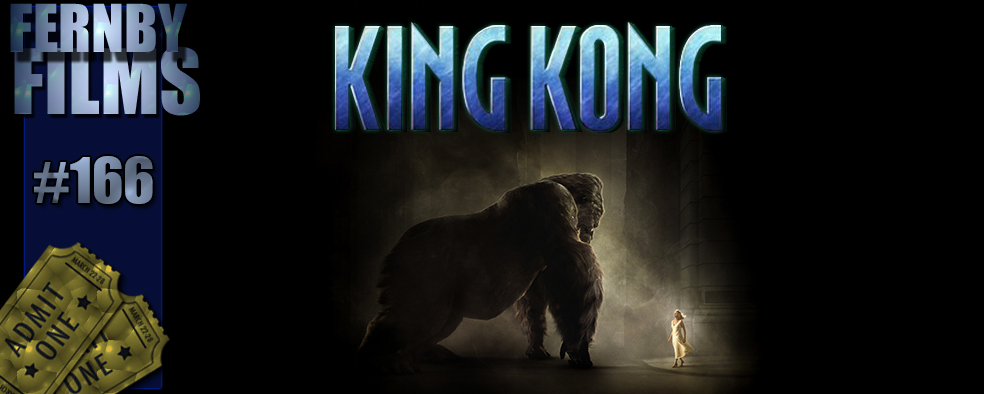
– Summary –
Director :Peter Jackson
Cast : Jack Black, Naomi Watts, Adrien Brody, Andy Serkis, Thomas Kretschmann, Colin Hanks, Jamie Bell, Evan Parke, Kyle Chandler, John Sumner, Lobo Chan, Craig Hall, Mark Hadlow, Jed Brophy.
Year Of Release : 2005
Length : 189 minutes
Synopsis: A filmmaker journeys to a mysterious island to film a movie, and instead discovers a giant ape; which he then see’s as a moneymaking idea and decides to capture it, to return it to America for profit.
*********
In his follow-up film to the enormous cinematic project that was The Lord Of The Rings, Peter Jackson was given a blank cheque by Universal Studios to undertake a remake of King Kong, the classic giant ape romp that was borne out of the 30’s. Whether this “blank-cheque” idea was a good one or not is perhaps answered by what Jackson delivered: a bloated, effects-driven spectacle film laced with action, humor and a certain degree of self-importance, something the original film did not. After all, is it always a good idea to remake a classic? Can you imagine somebody trying to re-do The Godfather? Perhaps not, although King Kong has been the subject of a few other remakes over the decades since his debut in 1933, all of varying quality and success.
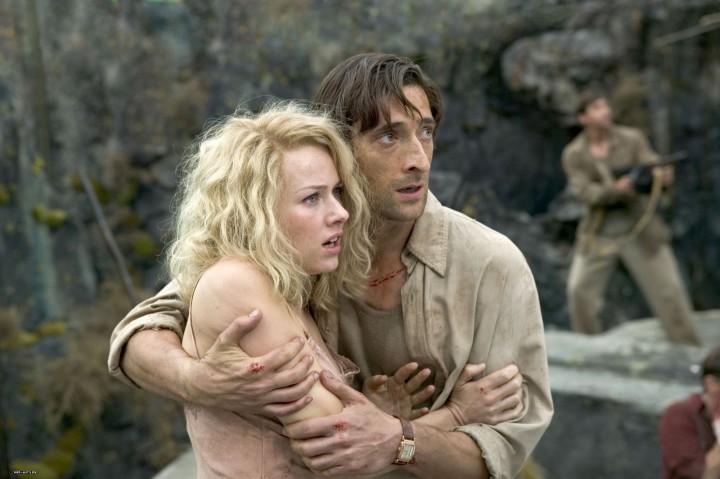 Jackson’s lavish treatment of the material, borrowed copiously from the ’33 version’s screenplay and expanded significantly by both Jackson and Fran Walsh, together with LOTR alum Phillipa Boyens, is an exercise in overblown dramatics and excess, something that worked so well in the LOTR trilogy, yet manages to remain somewhat anti-cool here. The concept of a giant ape swinging through 1930’s New York City is something that would make any film-lover drool with anticipation; after all, the Emmerich/Devlin Godzilla from a few years earlier had paved the way (although perhaps not in the right way!) for a revision of the giant ape and his beautiful, blonde attention seeker. The thought of all that destruction and fire-power being unleashed upon the screen by Jackson and his cohorts was too much for Universal to resist. Jackson (and his fellow writers) took the story originally written by Merian Cooper for the original film and expanded it, filled in the gaps, created more narrative and included more characters, trying to bulk out the film. It’s like Jackson wasn’t quite happy with the original and felt that, in this instance, bigger is better. Longer, more action, better effects, you name it, he wanted it.
Jackson’s lavish treatment of the material, borrowed copiously from the ’33 version’s screenplay and expanded significantly by both Jackson and Fran Walsh, together with LOTR alum Phillipa Boyens, is an exercise in overblown dramatics and excess, something that worked so well in the LOTR trilogy, yet manages to remain somewhat anti-cool here. The concept of a giant ape swinging through 1930’s New York City is something that would make any film-lover drool with anticipation; after all, the Emmerich/Devlin Godzilla from a few years earlier had paved the way (although perhaps not in the right way!) for a revision of the giant ape and his beautiful, blonde attention seeker. The thought of all that destruction and fire-power being unleashed upon the screen by Jackson and his cohorts was too much for Universal to resist. Jackson (and his fellow writers) took the story originally written by Merian Cooper for the original film and expanded it, filled in the gaps, created more narrative and included more characters, trying to bulk out the film. It’s like Jackson wasn’t quite happy with the original and felt that, in this instance, bigger is better. Longer, more action, better effects, you name it, he wanted it.
But, like most things, bigger doesn’t always mean better.
There are a few major issues with Jackson’s opus this time round, and most of them are nothing to do with the length of the film. Surprisingly, the storyline doesn’t justify such a bloated, slowly paced epic. While the original classic Kong ran at a surprisingly light 90-ish minutes, this version balloons out to three hours, a staggering running time considering there ain’t all that much meat on the storyline. And with a lack of depth to the characters, no matter how hard Jackson tries, our focus tends to be on the digital Kong, larger than life and twice as hairy, thundering across the screen in a cornucopia of whoops, whistles, roars and screams, all bombast and fury with little real emotional impact.
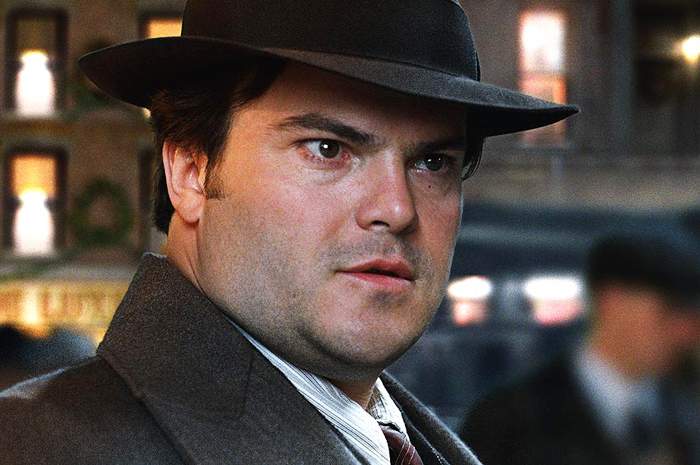 The film begins with a montage of New York during the Great Depression, recreated with loving detail on the backlot at WETA studios in Wellington, New Zealand, a far cry from the real place. People are out of work, starving, destitute, and looking for a way out of poverty. Ann Darrow (A luminous Naomi Watts… seriously, can this woman be any more beautiful projected on a twenty foot screen?), a struggling pantomime artist, stands before the doors to a strip-joint, her next meal an easy flash-of-boobs away, when Carl Denham walks past, and spots her. Denham is looking for a young, fresh faced girl to star in his next film project. Denham (Jack Black) is a weasel, portrayed as the scum of Hollywood lowlife you’d go out of your way not to associate with. He would sell his mother to make a quick buck, and have no qualms doing so. His associate, played by an underwhelming (and out of his depth) Colin Hanks, tries to be his voice of reason, but most of the time his words fall on Denham’s deaf ears. Denham is about an hour away from having his directorial career dumped, when he comes up with a magnificent plan. He dupes the studio into giving him a camera, he “commandeers” a boat to take him and his crew, plus Darrow and struggling writer Jack Driscoll (Adrien Brody, who is not a leading man Mr Jackson!) to a strange, scary island that’s not on any map. Skull Island, for want of a better title, is where Denham discovers Kong, the monstrous ape who lives among the prehistoric animals inhabiting the sanctuary. When Darrow is to be sacrificed to the giant ape by the local tribal inhabitants of the island, Kong finds himself in love with the woman; Ann dances and juggles and performs some of her slapstick panto repertoire for him, and he’s soon calm as an infant. Trouble is, such is Kong’s infatuation with Darrow, that when Denham and his cohorts arrive to try and save her, Kong goes… well, ape. Therein lies the plot device of this film: the connection between Anne, who see’s Kong as simply a giant ape all alone, and Kong, who feels he must protect Darrow against any threat.
The film begins with a montage of New York during the Great Depression, recreated with loving detail on the backlot at WETA studios in Wellington, New Zealand, a far cry from the real place. People are out of work, starving, destitute, and looking for a way out of poverty. Ann Darrow (A luminous Naomi Watts… seriously, can this woman be any more beautiful projected on a twenty foot screen?), a struggling pantomime artist, stands before the doors to a strip-joint, her next meal an easy flash-of-boobs away, when Carl Denham walks past, and spots her. Denham is looking for a young, fresh faced girl to star in his next film project. Denham (Jack Black) is a weasel, portrayed as the scum of Hollywood lowlife you’d go out of your way not to associate with. He would sell his mother to make a quick buck, and have no qualms doing so. His associate, played by an underwhelming (and out of his depth) Colin Hanks, tries to be his voice of reason, but most of the time his words fall on Denham’s deaf ears. Denham is about an hour away from having his directorial career dumped, when he comes up with a magnificent plan. He dupes the studio into giving him a camera, he “commandeers” a boat to take him and his crew, plus Darrow and struggling writer Jack Driscoll (Adrien Brody, who is not a leading man Mr Jackson!) to a strange, scary island that’s not on any map. Skull Island, for want of a better title, is where Denham discovers Kong, the monstrous ape who lives among the prehistoric animals inhabiting the sanctuary. When Darrow is to be sacrificed to the giant ape by the local tribal inhabitants of the island, Kong finds himself in love with the woman; Ann dances and juggles and performs some of her slapstick panto repertoire for him, and he’s soon calm as an infant. Trouble is, such is Kong’s infatuation with Darrow, that when Denham and his cohorts arrive to try and save her, Kong goes… well, ape. Therein lies the plot device of this film: the connection between Anne, who see’s Kong as simply a giant ape all alone, and Kong, who feels he must protect Darrow against any threat.
Denham, sensing an opportunity to become filthy rich, transports Kong back to New York, and puts the animal on display in a theater on Times Square. The human throng gathers, the lights go down, and, when the show begins, Kong appears unsettled. And when a terrified substitute Darrow is raised up onto the stage, bound before Kong on a giant stake, the ape is enraged. Breaking free of his chains, Kong explodes onto the streets of 1930’s New York with the intent of finding the “real” Ann Darrow.
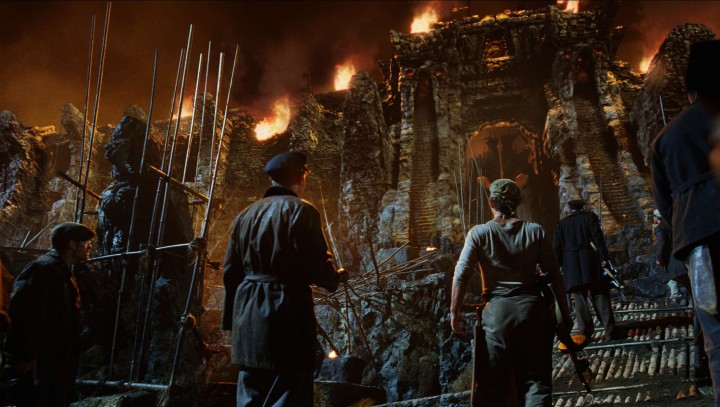 King Kong is a mammoth event picture, filled to the brim with wondrous CGI, lavish production values and a cast of real talent. Excluding Watts, as Ann, almost the entire cast is wasted or miscast: Jack Black and Adrien Brody are woefully out of their depth in this film, Black’s grating line delivery managing to ensure not only do we hate his character, but we develop not a skerrick of emotional connection with him. The rest of the cast, including Jackson alum Andy Serkis (in a dual role as Lumpy the ship’s cook, and the giant ape himself, Kong, in a performance capture effort that’s almost on par with Gollum) and Kyle Chandler, manage to scrape through their lines, without any conviction. The script is as flat as a pancake, lacking in any real depth, with little-to-no humor or actual drama derived from what is, essentially, a show-piece for WETA Digital. Jamie Bell, young star of Billy Elliot, is utterly wasted here, as are most of the cast, as they mug and gape in shock and awe as a giant ape rummages through the film around them. They are little more than glorified window dressing, and although Jackson tries hard to shove some character development into the screenplay, it doesn’t translate to the screen in a way that we connect with. And what Thomas Kretchmann is doing in this film is beyond me: why they needed to cast somebody of his caliber as a ships captain, and give him a role little more than an enlarged cameo, is simply arrogant to the extreme.
King Kong is a mammoth event picture, filled to the brim with wondrous CGI, lavish production values and a cast of real talent. Excluding Watts, as Ann, almost the entire cast is wasted or miscast: Jack Black and Adrien Brody are woefully out of their depth in this film, Black’s grating line delivery managing to ensure not only do we hate his character, but we develop not a skerrick of emotional connection with him. The rest of the cast, including Jackson alum Andy Serkis (in a dual role as Lumpy the ship’s cook, and the giant ape himself, Kong, in a performance capture effort that’s almost on par with Gollum) and Kyle Chandler, manage to scrape through their lines, without any conviction. The script is as flat as a pancake, lacking in any real depth, with little-to-no humor or actual drama derived from what is, essentially, a show-piece for WETA Digital. Jamie Bell, young star of Billy Elliot, is utterly wasted here, as are most of the cast, as they mug and gape in shock and awe as a giant ape rummages through the film around them. They are little more than glorified window dressing, and although Jackson tries hard to shove some character development into the screenplay, it doesn’t translate to the screen in a way that we connect with. And what Thomas Kretchmann is doing in this film is beyond me: why they needed to cast somebody of his caliber as a ships captain, and give him a role little more than an enlarged cameo, is simply arrogant to the extreme.
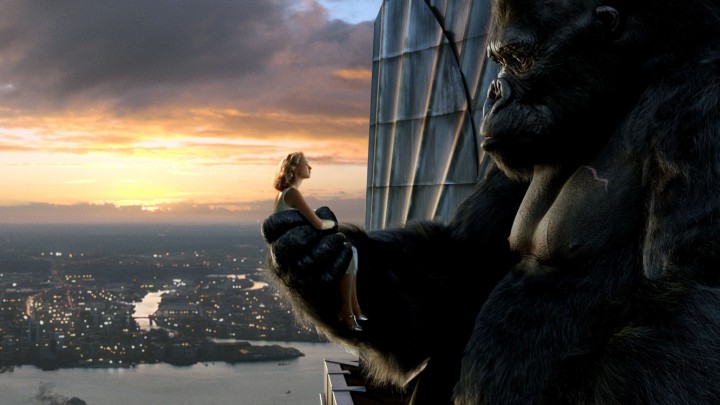 That said, what WETA have accomplished with Kong is nothing short of amazing. The giant ape battles dinosaurs, lizards, New York traffic, aeroplanes and eventually gravity, all superbly realized by some of the best computer guys in the business. Kong’s realism is superb, it’s almost hard to believe it’s a totally digital creation. The eyes, the soul of the giant ape, flash out from the screen, and if there’s a bright shining part of the film that is a testament to the power of a human story, it’s the connection between Kong and Ann: it’s truly palpable. Kong’s fur moves slightly in the breeze, his eyes glisten and glimmer in the changing light, his hair feels soft to the touch: yes, I have to say that Kong is about as close to CGI character perfection as the aforementioned Gollum. There’s a moment, at the very end of the film, with Kong and Ann on the very top of the Empire State Building, when Kong is mortally wounded, and collapses. He makes eye contact with Ann, and the two regard each other momentarily, before the giant ape plunges to his destruction. (Aww, c’mon, you know the story!) Watt’s plays this scene for keeps, with a level of screen chemistry I’ve only seen before from her once, in Mulholland Drive. And Kong, a totally digital (and imaginary) character, goes with her blow for blow on this one: it’s the one moment in the whole film you get a sense of any sort of truth to these characters. The animation and intensity of Kong here is superb.
That said, what WETA have accomplished with Kong is nothing short of amazing. The giant ape battles dinosaurs, lizards, New York traffic, aeroplanes and eventually gravity, all superbly realized by some of the best computer guys in the business. Kong’s realism is superb, it’s almost hard to believe it’s a totally digital creation. The eyes, the soul of the giant ape, flash out from the screen, and if there’s a bright shining part of the film that is a testament to the power of a human story, it’s the connection between Kong and Ann: it’s truly palpable. Kong’s fur moves slightly in the breeze, his eyes glisten and glimmer in the changing light, his hair feels soft to the touch: yes, I have to say that Kong is about as close to CGI character perfection as the aforementioned Gollum. There’s a moment, at the very end of the film, with Kong and Ann on the very top of the Empire State Building, when Kong is mortally wounded, and collapses. He makes eye contact with Ann, and the two regard each other momentarily, before the giant ape plunges to his destruction. (Aww, c’mon, you know the story!) Watt’s plays this scene for keeps, with a level of screen chemistry I’ve only seen before from her once, in Mulholland Drive. And Kong, a totally digital (and imaginary) character, goes with her blow for blow on this one: it’s the one moment in the whole film you get a sense of any sort of truth to these characters. The animation and intensity of Kong here is superb.
The rest of the film’s effects range from truly extraordinary, to the mediocre at best. The pit sequence, where Denham, Lumpy and a few others are savaged by increasingly carnivorous bugs, before being rescued, is an example of such mediocrity. Jackson has, with this scene, fallen prey to the trap most accomplished directors manage to steer clear from: a reliance on CGI to tell the story, not to assist in telling the story. It’s a scene simply for it’s own sake, and merely serves to lengthen the film. And the effects, while generally good, don’t hold up to the rest of the film. There’s no sense of continuity here.
Honestly, this is how I felt about a fair portion of the film anyway: most scenes and characters are secondary at best, with the exception of Denham, Driscoll, Ann and Kong. The rest are merely fodder for the beasts on the island, to be chewed up and spat out on a whim.
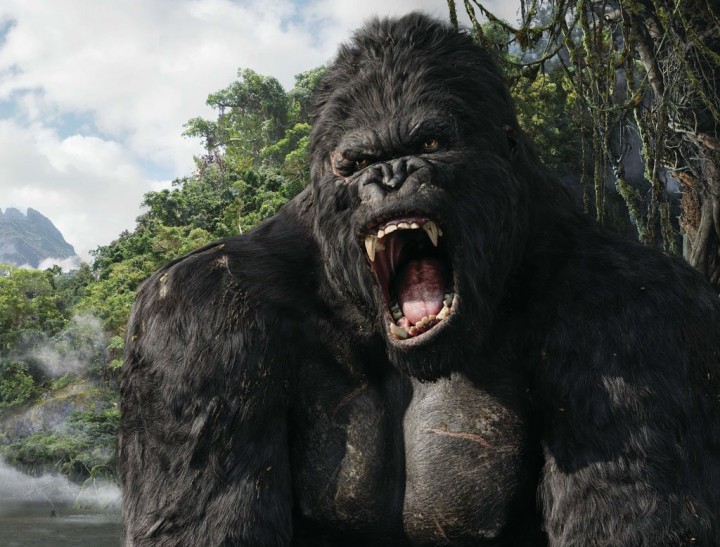 With a problematic script, casting that’s deplorably inadequate (just because you want to work with somebody, doesn’t mean they’ll fit into your movie!) and a seemingly endless array of dazzling, but pointless, action sequences, and some numbingly bad effects mixed with the good ones, and King Kong simply rises to the level of “good” and refuses to go any further. You can see what Jackson was hoping to achieve with King Kong; that is, to create an adventure film where the impossible happens and you are constantly surprised. The action scenes, including a dinosaur stampede and a battle between Kong and three dinosaurs, go on forever: some deserve it, such as the latter, and others, like the former, could have been removed completely from the film with little overall impact.
With a problematic script, casting that’s deplorably inadequate (just because you want to work with somebody, doesn’t mean they’ll fit into your movie!) and a seemingly endless array of dazzling, but pointless, action sequences, and some numbingly bad effects mixed with the good ones, and King Kong simply rises to the level of “good” and refuses to go any further. You can see what Jackson was hoping to achieve with King Kong; that is, to create an adventure film where the impossible happens and you are constantly surprised. The action scenes, including a dinosaur stampede and a battle between Kong and three dinosaurs, go on forever: some deserve it, such as the latter, and others, like the former, could have been removed completely from the film with little overall impact.
And I guess that’s the great shame, really. If you can remove whole sequences from the film, and it doesn’t change anything overall, then why put those scenes in in the first place? Padding out an already paper-thin plot is ludicrously pompous, as is shoehorning a few extra minutes of action into a film already teeming with them. Jackson needs to learn how to trim the fat, and recognize when he’s gone beyond making a simple blockbuster action film, and into a bloated, bombastic, jawdropping, hodge-podge of semi-decent ideas and some truly awesome digital effects. There’s enough in this film to make two pictures, and perhaps it’s a shame Jackson didn’t leave some stuff out so he could do just that. But I guess, when money is no object (and that’s what it appears to be) then you can do whatever you like.
Overall, King Kong is a lavish, expensive tribute to a far better film, the 1930’s version of Kong. Universal may have made back their money on this epic, however, the question must be asked if it was required to remake such a classic movie in the first place. In an end result a little similar to the remake of Godzilla back in ’97, this King Kong is longer, more obsequious and a lot less subtle. And certainly filled with problems. While on a superficial level it may be generally entertaining, and filled with the “wonder and excitement” that only the movies can generate, if you re-watch the film a few times, eventually, the cracks start to appear. Which is disappointing, especially after the success of Lord Of The Rings.
Still, for something to watch to while away the time, and perhaps not make you have to think too much, then Kong can come recommended.











